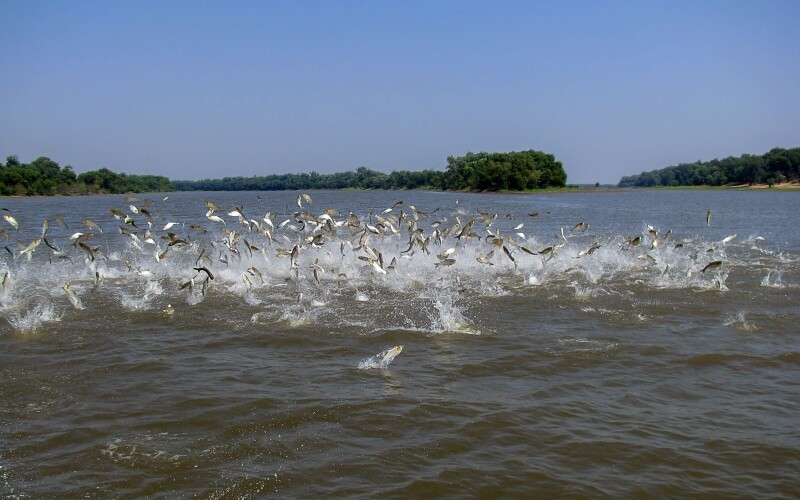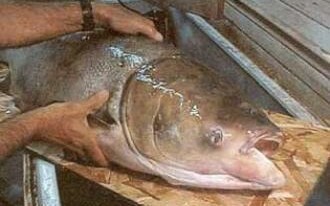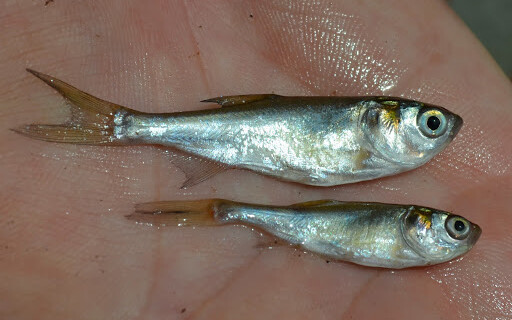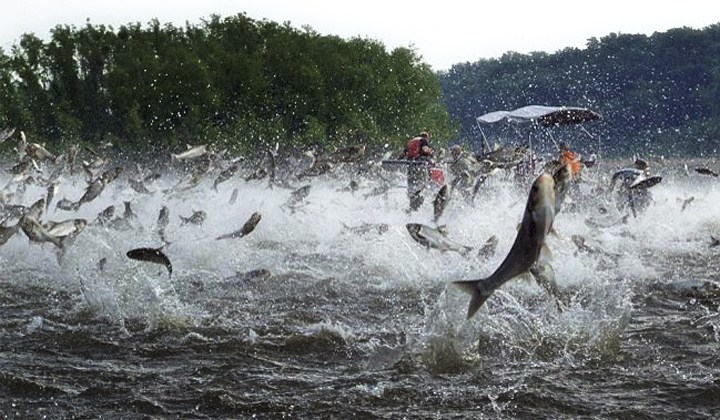Asian carp may be on decline in Tennessee; fishing a factor
Published onCHATTANOOGA, Tenn. Eyeballing his Garmin LiveScope screen, my guide for the day, Jason Sealock, pointed and said, The brush pile is about 20 feet that way. I dropped a jig exactly where he said, let it fall to a 10-count and began a slow retrieve. I hadnt turned the reel handle five cranks when I felt the tell-tale Thump, and quickly brought the 11-inch Kentucky Lake crappie to the boat. Read more
Read MoreResearchers: market for Asian carp could slow invasion
Published onMidwestern states are spending millions every year to prevent a giant, goggle-eyed fish from invading rivers and lakes. But the Asian carp has firmly established a home in the Mississippi River basin, and experts say they are here to stay. Now, researchers are hoping that creating new markets for the invasive fish could be part of the solution. Read more
Read MoreArmy Corps planning $1.4B carp barricade for Illinois
Published onScott Whitney, of the Army Corps of Engineers, stands on a peninsula of the Des Plaines River carved out nearly a century ago to make way for the Brandon Road Lock and Dam in Joliet As a chief of project management with the Army Corps, Whitney helps to make sure the invasive carp that took over parts of the Illinois River in the 1990s dont make it to the other side. Read more
Read More750,000 pounds of invasive carp removed from Illinois River
Published onSPRINGFIELD, Ill. (WICS) The Illinois Department of Natural Resources removed 750,000 pounds of silver carp from the Illinois River between Nov. 27 and Dec. 6. This is the largest single removal effort IDNR has undertaken and is believed to be a record for freshwater harvest within the United States. Read more
Read MoreMinnesota legislature declines to fund invasive carp barrier
Published onWith a historic $17 billion state budget surplus this year, environmental advocates hoped Minnesota lawmakers would make a big investment to stop the advance of invasive carp up the Mississippi River. It was an opportune moment to do some big things this year, said Whitney Clark, executive director of the nonprofit Friends of the Mississippi River, a member of the Stop Carp Coalition. Read more
Read MoreResearchers, local officials battling to halt spread of invasive carp
Published onInvasive carp are swimming north through American waterways and wreaking havoc on ecosystems. The fish can withstand a variety of environments, survive for decades and lay millions of eggs, which allows them to supplant native species. The filter feeders eat plankton and small fish, outcompeting other fish for food. Read more
Read MoreArmy Corps approves $778M plan to push back Asian carp
Noisemakers, electric cables and other devices are part of a $778 million plan approved by the Army Corps of Engineers last week to fortify an Illinois waterway and keep invasive Asian carp from reaching the Great Lakes. Lt. Gen. Todd Semonite sent the proposed plan to Congress for evaluation last week, explaining the defenses that would be installed at the Brandon Road Lock and Dam near Joliet, Ill., about 40 miles from Lake Michigan, a key choke point in a pathway between the lake and the carp-infested Illinois River. “This report gives Congress what it needs to authorize funding for the project and finally advance a much-needed, long-term solution,” said U.S. Sen. Debbie Stabenow (D-Mich.). If approved, the plan would establish new electric barriers to stop Asian carp from moving through the lock and dam, and install underwater speakers that would blast sound waves at ...
Read MoreLouisiana chef leads charge on rebranding Asian carp
Can’t Beat ’Em, Eat ’Em campaign aims to market invasive species as silverfin Along the Mississippi River, fishermen and chefs are heading an effort to rid the ecosystem of invasive bighead and Asian silver carp the only way they know how — catching and eating them. The two species were introduced to fish farm ponds in the central Midwest in the 1970s to clean murky pond water. Flooding allowed their escape into rivers, where they have reproduced in the wild and are outcompeting native species. Louisiana Chef Philippe Parola has been expressing concern for native species of fish in Louisiana for years, worried about how shrimp, oyster, blue crab and other finfish that rely on plankton-rich waters could be destroyed by a sizable Asian carp population. Parola has been on a campaign to convince officials in Louisiana and Illinois to support the Can’t Beat ‘Em, Eat ‘Em effort ...
Read MoreMichigan ponders plan to stop carp
The Michigan Department of Natural Resources wants to keep invasive Asian carp out of the Great Lakes. The state recently authorized $1 million to launch a global search for ideas to prevent the looming carp invasion. According to the Michigan DNR, silver carp and bighead carp are within 10 miles of the three electric barriers built to prevent invasive carp from entering Lake Michigan through the Chicago Area Waterways System. An Asian carp invasion could be devastating to Great Lakes fisheries because the carp would harm native fish by taking their food and habitat. Asian carp are prolific breeders that can reach 50-pounds. The filter-feeding invasive fish consume massive amounts of the tiny plants (phytoplankton) and animals (zooplankton) that feed native forage species, along with juvenile sport fish such as walleye and yellow perch. The specifies is a significant threat to the Great Lakes’ $7 billion fishing industry ...
Read More








